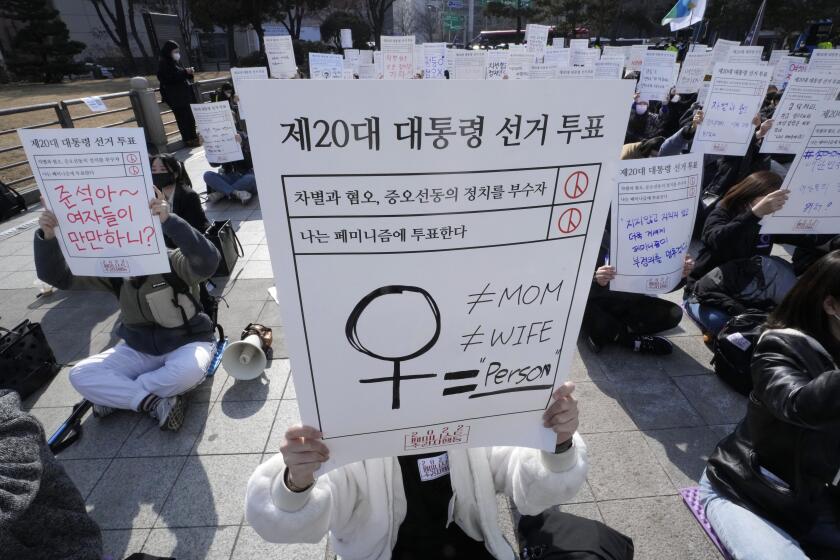Oil Makes Biggest Price Jump Since Gulf War
- Share via
Oil prices soared 13% on Monday and gasoline prices were poised to follow after several Middle Eastern oil producers announced that they would follow the lead of Saudi Arabia, Mexico and Venezuela and cut output to shore up world prices.
In the biggest one-day percentage rise since the days of the Persian Gulf War, oil jumped $1.90 to $16.51 a barrel on the New York Mercantile Exchange, racing back from last week’s slide below $13.
The agreement among major oil exporters called a halt, at least for now, to a prolonged plunge in prices that has proved a boon to industrialized economies, further damping inflation and partly offsetting the global impact of the Asian economic crisis.
The oil glut had also helped to send gasoline prices tumbling well below $1 a gallon in California and the rest of the United States. But in California, that decline had already bottomed out and pump prices had begun to inch higher with increased seasonal demand by motorists and the annual refinery conversion to more expensive hot-weather gasoline.
“It’s still easy to find gasoline for less than $1, but the motto should be, ‘Top off today,’ ” quipped Michael Morrissey, a spokesman for AAA, formerly the Automobile Assn. of America.
Still, analysts were skeptical that the deal reached Sunday in Saudi Arabia to cut production by up to 2 million barrels a day would be enough to send prices through the roof. And it remains to be seen whether the agreement will hold.
“It’s a good first step” in stopping the collapse of oil prices, said Michael Mayer, managing director of Schroder Wertheim & Co. in Burlingame, Calif. “I don’t think we have to worry about $10, $11 or $12 [per barrel] oil, but the possibility of $18 or $19 oil is not very good.”
Oil futures last week plummeted to a nine-year low of $12.80 a barrel, which--when adjusted for inflation--represented the lowest price paid for oil since the 1960 formation of the Organization of Petroleum Exporting Countries. Monday’s price surge was the biggest one-day gain in percentage terms since a 13.5% rise on Jan. 22, 1991, during the Persian Gulf War.
But oil prices are still far below the $23-a-barrel level of September, two months before OPEC reached its ill-fated agreement to increase production 10% starting Jan. 1. Since then, a battle between Venezuela and Saudi Arabia has pushed each country to boost production still higher while worldwide demand has fallen because of an unusually warm winter and Asian economic problems, creating an enormous glut of oil.
OPEC’s glory days are long gone, and it is unclear whether Iran, Kuwait, the United Arab Emirates, Nigeria, Libya and Algeria--which said Monday they will join in the production cutback--will muster the discipline that has failed them routinely for years. And oil watchers are doubtful that OPEC will be able to count on the long-term cooperation of the non-OPEC countries that joined in the agreement: Mexico and Oman.
In addition, Iraq will soon begin increasing oil exports in its United Nations-brokered oil-for-food deal, which will offset about one-third of the expected production cuts that were announced Sunday.
Meanwhile, the price of regular unleaded gasoline, which stood Monday at an average $1 a gallon nationwide, should begin to rise by as much as 10 cents a gallon as summer approaches, said John Cook, director of the petroleum division of the Energy Information Administration, which is part of the U.S. Energy Department. A week ago, the average price was $1.008 a gallon.
“If oil stays up, then gas prices will follow right along,” Cook said. “But I don’t think it’s going to be nearly as much ‘fun’ as last summer,” when the price of full-service premium unleaded was spotted selling above $2 a gallon in Southern California.
While the price of crude oil ultimately drives gasoline prices, numerous other factors come into play at the local level, including demand, competition, and the ability of refineries to maintain production levels.
Local gas station owners said Monday they hadn’t yet felt repercussions from the jump in crude oil prices, but some said that could change with their next shipment of gasoline.
Luis Lopez of Lopez Chevron in Los Angeles said he expects that higher oil prices will push his own gas prices up an additional 3 cents a gallon, possibly as early as today.
“I bet we get a notice over the computer tonight,” said Lopez, who has owned his station at Fletcher and Riverside drives for 25 years. “Chevron’s always the first to raise prices.”
Chevron declined comment on the pricing outlook.
But consumers should not expect any dramatic price spikes in gasoline, said Bob Aldrich, a spokesman for the California Energy Commission.
“Prices always go up faster than they come down, of course,” Aldrich said, “. . . but we’re sitting really well in terms of what we’ve got in storage and the refineries are just cranking it out,” producing gasoline at near capacity.
Lower energy prices have aided a wide range of industries across the U.S. economy by reducing inflation not only through lower transportation and fuel prices, but also because oil is used to make so many different products, thereby reducing costs to a wide range of manufacturers.
The Federal Reserve last week described the pressures on product prices as “eerily calm” and the Labor Department. said a 2.2% drop in energy prices in February held the overall increase in the Consumer Price Index to a mere 0.1%.
The 10 nations participating in the oil production agreement have so far pledged cuts of 1.3 million barrels a day, or about 2% of the 74.7 million barrels of oil produced worldwide in February.
The oil ministers of Saudi Arabia, Venezuela and Mexico agreed to try to persuade OPEC and non-OPEC oil producers to pull up to 2 million barrels a day from world oil markets.
OPEC members are scheduled in Vienna on Monday to discuss the production agreement. The last time OPEC lowered its production quota was in February 1993, when it cut output by 1 million barrels a day--but prices still plunged 27% that year because countries later boosted production.
Whether OPEC members will abide by the agreement and whether non-OPEC countries will stay in line are key questions that can’t be answered. The higher prices that the market produced overnight could create the inevitable temptation for oil countries to open the spigots too wide once again.
“We’re encouraged by the fact that it included some non-OPEC producers this time,” said Mark Hastings, an energy analyst with Merrill Lynch & Co.
Special correspondent Stephen Gregory and Times wire services contributed to this story.
* VENEZUELA’S CLOUT: Decision to cut output shows power to sway the market. D1
(BEGIN TEXT OF INFOBOX / INFOGRAPHIC)
Price Rise
Increasing oil prices due to a cut in oil production will likely lead to higher prices at the pump. Price per barrel on the New York Mercantile Exchange:
Monday: $16.51
Source: Bloomberg News
More to Read
Sign up for Essential California
The most important California stories and recommendations in your inbox every morning.
You may occasionally receive promotional content from the Los Angeles Times.













